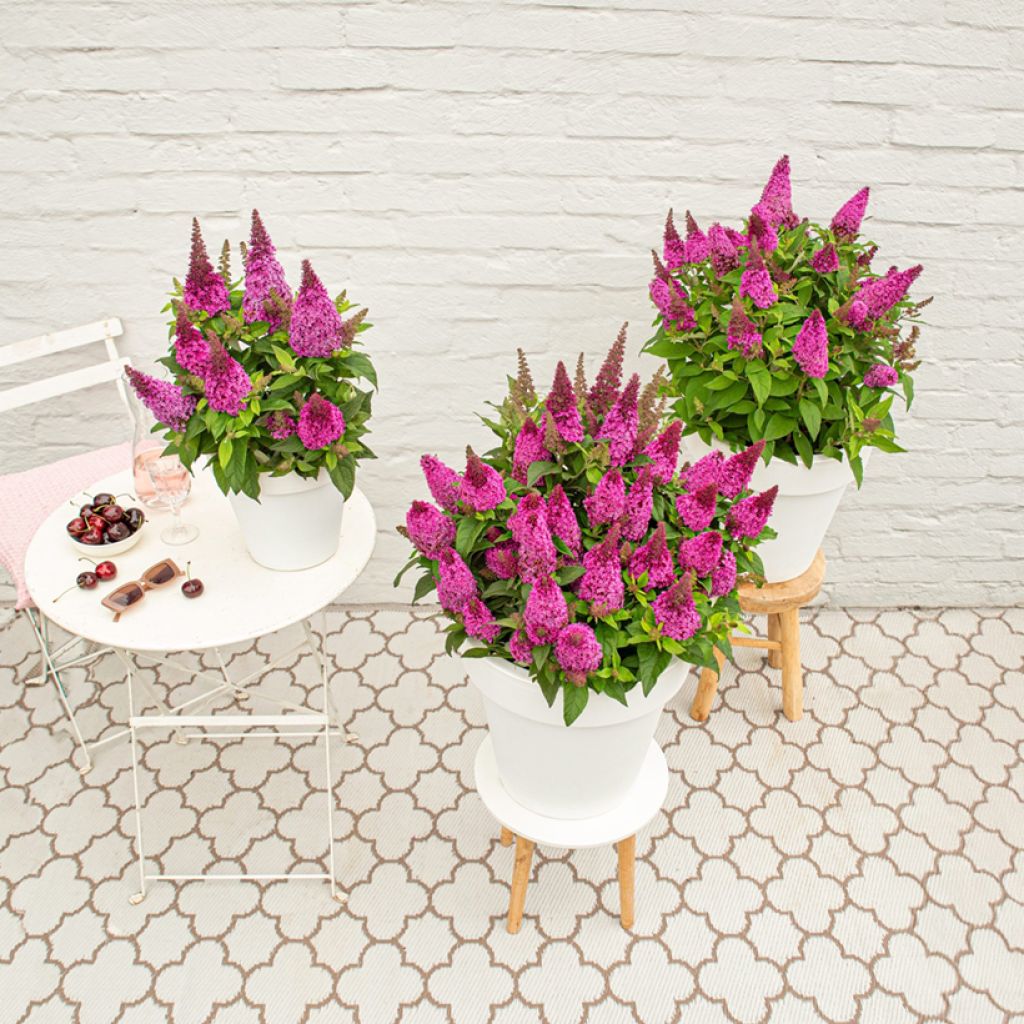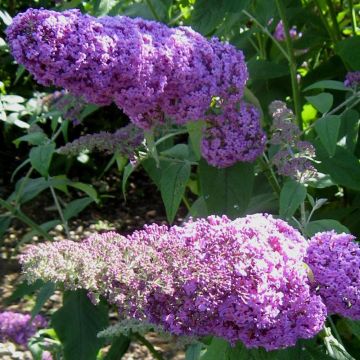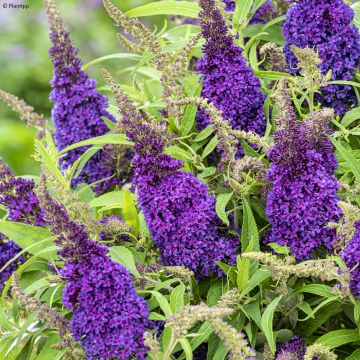

Buddleja x davidii Butterfly Candy® Little Cerise - Butterfly Bush


Buddleja x davidii Butterfly Candy® Little Cerise - Butterfly Bush


Buddleja x davidii Butterfly Candy® Little Cerise - Butterfly Bush


Buddleja x davidii Butterfly Candy® Little Cerise - Butterfly Bush
Buddleja x davidii Butterfly Candy® Little Cerise - Butterfly Bush
Buddleja x davidii Butterfly Candy® Little Cerise ('BotEx 007'PBR) EU 20231689
Butterfly Bush, Summer Lilac, Orange Eye
Special offer!
Receive a €20 voucher for any order over €90 (excluding delivery costs, credit notes, and plastic-free options)!
1- Add your favorite plants to your cart.
2- Once you have reached €90, confirm your order (you can even choose the delivery date!).
3- As soon as your order is shipped, you will receive an email containing your voucher code, valid for 3 months (90 days).
Your voucher is unique and can only be used once, for any order with a minimum value of €20, excluding delivery costs.
Can be combined with other current offers, non-divisible and non-refundable.
Home or relay delivery (depending on size and destination)
Schedule delivery date,
and select date in basket
This plant carries a 24 months recovery warranty
More information
We guarantee the quality of our plants for a full growing cycle, and will replace at our expense any plant that fails to recover under normal climatic and planting conditions.
Would this plant suit my garden?
Set up your Plantfit profile →
Description
The Buddleja davidii Butterfly Candy® Little Cerise is a compact variety of Bush with a dense habit and a long delicately scented summer flowering. Ideal for small gardens and container growing on a balcony or terrace, this Buddleia stands out for its elegance and balanced silhouette. From early summer to autumn, it is adorned with spikes of fuchsia pink to dark pink conical flowers, very attractive to butterflies and bees, which contrast beautifully with its silver-grey green foliage. Hardy and easy to maintain, this dwarf Bush is an excellent choice to promote biodiversity in the garden.
The genus Buddleja includes around a hundred species of deciduous or evergreen bushes, originating from China, Africa, South Asia, and South America. They owe their name to Adam Buddle, a famous English botanist of the 17th century. This genus may sometimes be spelled 'Buddleia', but the official spelling appears to be 'Buddleja'. Belonging to the Buddlejaceae family, the Buddleja davidii Butterfly Candy® Little Cerise is a hybrid, recently selected in the Netherlands by Botanic Experience BV and the Dutch breeder Van Son & Koot from Kaatsheuvel. In 2024, it was awarded the bronze medal at the KVBC Plantarium GroenDirekt by the Royal Association for Cultures of Boskoop.
The Buddleia Little Cerise is a small plant with a rounded habit not exceeding 80 cm. This variety develops highly branched vegetation, with short upright branches, providing it with a balanced stature. The deciduous foliage falls in winter and regrows in spring. It consists of lanceolate opposite leaves measuring approximately 8 to 10 cm long by 2 to 3 cm wide, slightly villous, in a silver-grey-green colour. The flowering period spans 4 to 5 months, from June-July to October, depending on the regions. It is composed of small dark red tubular flowers, clustered in long conical panicles at the end of branches, 10 to 15 cm long. The flowers release a sweet scent reminiscent of honey, highly sought after by pollinating insects and butterflies. In the summer, after each wave of flowers, light pruning encourages the buddleia to develop new flowering shoots. This bush, very hardy, resists urban pollution very well and does not suffer from occasional drought. It appreciates very sunny or slightly shaded locations, sheltered from strong winds. It tolerates all types of soils, even poor and chalky ones, and prefers a deep, well-drained, slightly enriched soil. Protect it from excess moisture in winter. Grown in pots, it will require regular watering and some fertiliser inputs to support its growth and flowering.
In the category of Buddleias, the diversity of varieties is remarkable, each with its own characteristics. The Buddleja davidii Butterfly Candy® Little Cerise stands out for its graphic habit and the intensity of its subtly scented flowering. Thanks to its compact form, this dwarf Buddleia is perfectly suited for container growing, ideal for enhancing terraces and balconies alongside other Shrubs for pots. Its silver-grey-green foliage contrasts beautifully with its vibrant flowers, making it easy to pair with colourful perennials like Asters, Delphiniums, Echinaceas, Daylilies, Red Hot Pokers. It also pairs very well with Roses for flowerbeds, medium height ornamental grasses, or flowering bushes such as Abelias, Caryopteris, Lavenders, Cinquefoils, Spiraeas. Placed near a terrace, along a pathway border or integrated into a flowering hedge, this Buddleia will enliven your flowerbeds and borders from summer to autumn, providing an appreciable decorative touch.
Buddleja x davidii Butterfly Candy® Little Cerise - Butterfly Bush in pictures


Plant habit
Flowering
Foliage
Botanical data
Buddleja
x davidii
Butterfly Candy® Little Cerise ('BotEx 007'PBR) EU 20231689
Scrophulariaceae
Butterfly Bush, Summer Lilac, Orange Eye
Cultivar or hybrid
Other Buddleja -Butterfly bush
View all →Planting and care
The Buddleja davidii Little Cerise is easy to grow, as it is a plant that is not very demanding in terms of soil. It appreciates sunny locations, but also flowers in partial shade. Plant it in spring or early autumn, in ordinary soil, even limestone and poor, but well worked and well-drained, fairly deep. Once well established, the plant will withstand periods of moderate drought. The David's buddleia has no significant enemies. However, be careful of caterpillars, vine weevils, bugs, and red spiders that can infest it.
The Buddleja davidii Butterfly Candy® can be planted in outdoor containers. Choose a container of at least 20 L. Make sure the container is pierced and provide good drainage by filling the bottom with a thick layer of clay pellets or gravel. In pots, they will naturally require more regular watering. In winter, move them to a sheltered place from the wind and stop watering during freezing periods.
In pots, the nutrient reserves deplete quickly. In spring, every year, to stimulate flowering, apply at once, 1 to three handfuls of organic fertilizer (decomposed manure, compost, Horn, blood, and specific fertilizers). Then, at least every two years, carry out a top dressing, which involves replacing at least the topsoil with fresh compost.
Planting period
Intended location
Care
Planting & care advice
This item has not been reviewed yet - be the first to leave a review about it.
Similar products
Haven't found what you were looking for?
Hardiness is the lowest winter temperature a plant can endure without suffering serious damage or even dying. However, hardiness is affected by location (a sheltered area, such as a patio), protection (winter cover) and soil type (hardiness is improved by well-drained soil).

Photo Sharing Terms & Conditions
In order to encourage gardeners to interact and share their experiences, Promesse de fleurs offers various media enabling content to be uploaded onto its Site - in particular via the ‘Photo sharing’ module.
The User agrees to refrain from:
- Posting any content that is illegal, prejudicial, insulting, racist, inciteful to hatred, revisionist, contrary to public decency, that infringes on privacy or on the privacy rights of third parties, in particular the publicity rights of persons and goods, intellectual property rights, or the right to privacy.
- Submitting content on behalf of a third party;
- Impersonate the identity of a third party and/or publish any personal information about a third party;
In general, the User undertakes to refrain from any unethical behaviour.
All Content (in particular text, comments, files, images, photos, videos, creative works, etc.), which may be subject to property or intellectual property rights, image or other private rights, shall remain the property of the User, subject to the limited rights granted by the terms of the licence granted by Promesse de fleurs as stated below. Users are at liberty to publish or not to publish such Content on the Site, notably via the ‘Photo Sharing’ facility, and accept that this Content shall be made public and freely accessible, notably on the Internet.
Users further acknowledge, undertake to have ,and guarantee that they hold all necessary rights and permissions to publish such material on the Site, in particular with regard to the legislation in force pertaining to any privacy, property, intellectual property, image, or contractual rights, or rights of any other nature. By publishing such Content on the Site, Users acknowledge accepting full liability as publishers of the Content within the meaning of the law, and grant Promesse de fleurs, free of charge, an inclusive, worldwide licence for the said Content for the entire duration of its publication, including all reproduction, representation, up/downloading, displaying, performing, transmission, and storage rights.
Users also grant permission for their name to be linked to the Content and accept that this link may not always be made available.
By engaging in posting material, Users consent to their Content becoming automatically accessible on the Internet, in particular on other sites and/or blogs and/or web pages of the Promesse de fleurs site, including in particular social pages and the Promesse de fleurs catalogue.
Users may secure the removal of entrusted content free of charge by issuing a simple request via our contact form.
The flowering period indicated on our website applies to countries and regions located in USDA zone 8 (France, the United Kingdom, Ireland, the Netherlands, etc.)
It will vary according to where you live:
- In zones 9 to 10 (Italy, Spain, Greece, etc.), flowering will occur about 2 to 4 weeks earlier.
- In zones 6 to 7 (Germany, Poland, Slovenia, and lower mountainous regions), flowering will be delayed by 2 to 3 weeks.
- In zone 5 (Central Europe, Scandinavia), blooming will be delayed by 3 to 5 weeks.
In temperate climates, pruning of spring-flowering shrubs (forsythia, spireas, etc.) should be done just after flowering.
Pruning of summer-flowering shrubs (Indian Lilac, Perovskia, etc.) can be done in winter or spring.
In cold regions as well as with frost-sensitive plants, avoid pruning too early when severe frosts may still occur.
The planting period indicated on our website applies to countries and regions located in USDA zone 8 (France, United Kingdom, Ireland, Netherlands).
It will vary according to where you live:
- In Mediterranean zones (Marseille, Madrid, Milan, etc.), autumn and winter are the best planting periods.
- In continental zones (Strasbourg, Munich, Vienna, etc.), delay planting by 2 to 3 weeks in spring and bring it forward by 2 to 4 weeks in autumn.
- In mountainous regions (the Alps, Pyrenees, Carpathians, etc.), it is best to plant in late spring (May-June) or late summer (August-September).
The harvesting period indicated on our website applies to countries and regions in USDA zone 8 (France, England, Ireland, the Netherlands).
In colder areas (Scandinavia, Poland, Austria...) fruit and vegetable harvests are likely to be delayed by 3-4 weeks.
In warmer areas (Italy, Spain, Greece, etc.), harvesting will probably take place earlier, depending on weather conditions.
The sowing periods indicated on our website apply to countries and regions within USDA Zone 8 (France, UK, Ireland, Netherlands).
In colder areas (Scandinavia, Poland, Austria...), delay any outdoor sowing by 3-4 weeks, or sow under glass.
In warmer climes (Italy, Spain, Greece, etc.), bring outdoor sowing forward by a few weeks.



























































